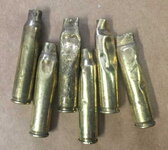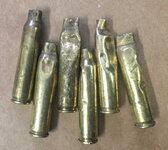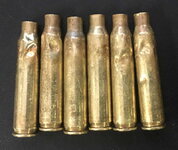Bronze Lifetime
- Messages
- 4,940
- Reactions
- 13,032
OK, I need a disclaimer right at the top, since the last time I did this a few people misunderstood. Perhaps I should ask, "Could you load this if you really needed to?"
No, I would not normally load these. They would go directly into my scrap bucket, if I even bothered picking them up. No, I don't recommend using junk. This is really just an academic exercise.
The idea came up when a friend and I were at the range. We were picking up some brass, and he made a comment something along the lines of how if the ammo panic keeps up, and/or restrictions make it difficult to get ammo, a person might need to try to load some of the reject, garbage brass I picked up.
I said it might surprise you what you can safely load, and pointed to some severely dented 5.56 brass, and then some nasty brown, tarnished, dirty 9mm brass in the dirt. He said no way; that would blow up in your gun. OK, challenge accepted.
![IMG_9571[1].jpg IMG_9571[1].jpg](data:image/svg+xml;charset=utf-8,%3Csvg xmlns%3D'http%3A%2F%2Fwww.w3.org%2F2000%2Fsvg' width='176' height='150' viewBox%3D'0 0 176 150'%2F%3E)

No, I would not normally load these. They would go directly into my scrap bucket, if I even bothered picking them up. No, I don't recommend using junk. This is really just an academic exercise.
The idea came up when a friend and I were at the range. We were picking up some brass, and he made a comment something along the lines of how if the ammo panic keeps up, and/or restrictions make it difficult to get ammo, a person might need to try to load some of the reject, garbage brass I picked up.
I said it might surprise you what you can safely load, and pointed to some severely dented 5.56 brass, and then some nasty brown, tarnished, dirty 9mm brass in the dirt. He said no way; that would blow up in your gun. OK, challenge accepted.
![IMG_9571[1].jpg IMG_9571[1].jpg](https://data.northwestfirearms.com/attachments/724/724209-0fbade23818f9c84a6fbf76c748815a6.jpg)

Last Edited:






![IMG_9843[1].jpg IMG_9843[1].jpg](https://data.northwestfirearms.com/attachments/724/724268-088051ddfd0ebef66cf6834d23149e75.jpg)
![IMG_9847[1].jpg IMG_9847[1].jpg](https://data.northwestfirearms.com/attachments/724/724269-cff3e691e2475541c17ac3032bcccc2a.jpg)









